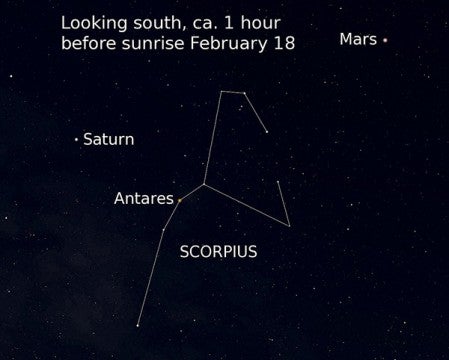Star Watch: A string of pearls
Published 7:18 am Sunday, January 31, 2016
 By Deane Morrison
By Deane Morrison
University of Minnesota
The shortest month opens with a long line of planets strung across the morning sky.
Look about an hour before sunrise on the 1st and find Venus, bright but very low, in the southeast, with much dimmer Mercury to its lower left. Far to Venus’s upper right shines Saturn, and in the south a last-quarter moon has just passed above Mars. Finally, in the southwest, Jupiter beams high and bright. You may also make out the stars Antares, the heart of Scorpius, below and right of Saturn; and Spica, in Virgo, between Mars and Jupiter.
Between the 3rd and the 6th, a waning crescent moon sweeps by Saturn, Venus and Mercury. On the 6th, the moon will be thinnest and closest to the sun. But it may come in handy when you look for Mercury; the little planet will appear beneath the lower cusp of the moon’s crescent.
Meanwhile, Mars and Antares–whose name means “rival of Mars”–draw closer. An especially good time to compare these two red beacons is the third week of February, when the distance between them will be short and no moon will be around to wash them out.
As for Jupiter, it is also an evening planet. Look for it in the east by about 9:30 p.m., earlier as the month goes by.
Orion, Gemini, Taurus and other bright winter constellations are in the south after nightfall and high enough for easy viewing from about 8 to 10 p.m. If you’re blessed with both dark skies and ambition, grab a star chart and try to make out the forms of Canis Major, Orion’s large hunting dog, which contains brilliant Sirius; and Lepus, the rabbit, an obscure constellation just below Orion. Binoculars will help.
February’s moon reaches fullness at 12:20 p.m. on the 22nd, but it won’t rise until shortly after sunset that evening. Algonquin Indians called this the snow moon, and some tribes called it the hunger moon because the heavy snows made hunting difficult.
On the 2nd we celebrate Groundhog Day, an old Celtic holiday based on astronomy. It is one of the four cross-quarter days falling midway between a solstice and an equinox. Groundhog Day began as Imbolc, which meant lamb’s milk, as it coincided with the start of the lambing season. It was held that if the day was sunny (which would make for clear shadows), that meant continued cold. But cloudy weather portended rains to soften the earth for planting.
Astronomers at Caltech have just reported evidence for a giant planet far beyond Neptune and Pluto. Nicknamed Planet Nine, it has never been seen; instead, its presence was betrayed by the behavior of several other objects in the region beyond Neptune that appeared to have been herded into unusual orbits by a massive celestial body. Evidence suggests that such an object would have 10 times the mass of Earth and orbit, on average, at 20 times the distance of Neptune, whose average orbital distance is 2.8 billion miles.
The University of Minnesota offers public viewings of the night sky at its Duluth and Twin Cities campuses. For more information and viewing schedules, see:
Duluth, Marshall W. Alworth Planetarium: www.d.umn.edu/planet
Twin Cities, Minnesota Institute for Astrophysics (during fall and spring semesters): www.astro.umn.edu/outreach/pubnight.
Check out the astronomy programs at the University of Minnesota’s Bell Museum ExploraDome: www.bellmuseum.umn.edu/ForGroups/ExploraDome/index.htm.
Contact: Deane Morrison, University Relations, (612) 624-2346,morri029@umn.edu
Find U of M astronomers and links to the world of astronomy athttp://www.astro.umn.edu.

